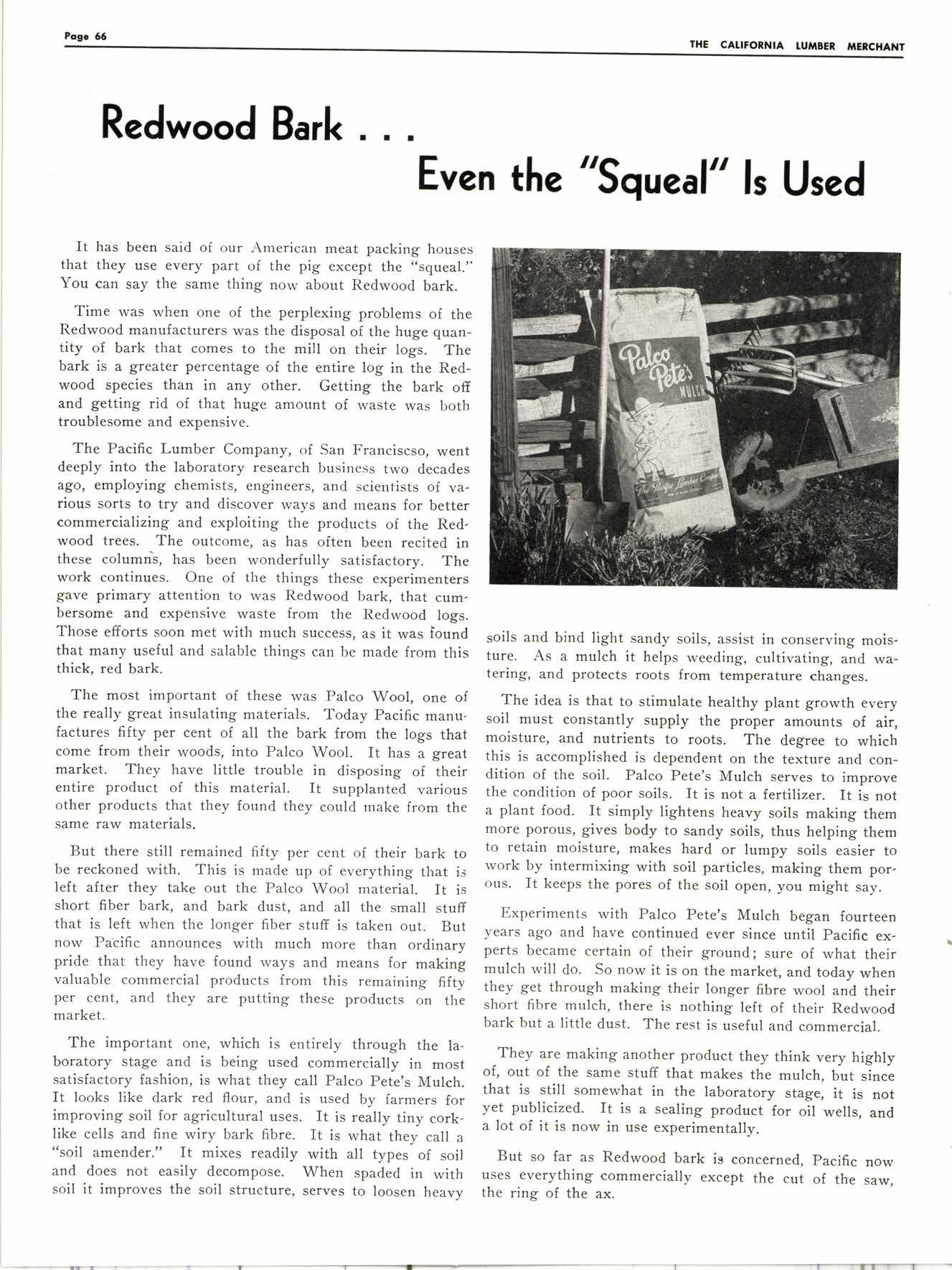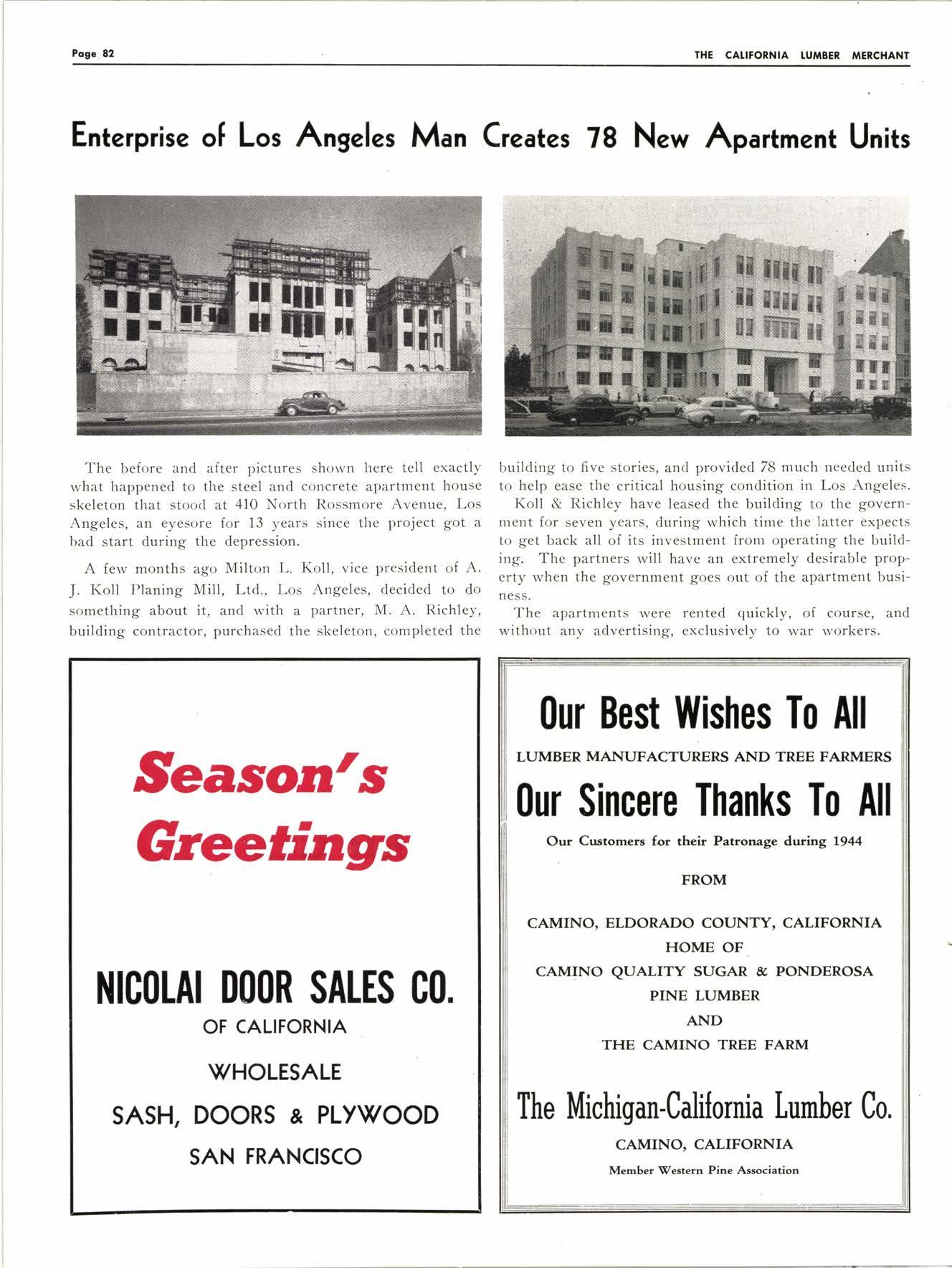
3 minute read
RedwoodBark..r Even the "Squ eal" fs Us ed
It has been said of our American meat packing houses that they use every part of the pig except the "squeal." You can say the same thing now about Redwood bark.
Time was when one of the perplexing problems of the Redwood manufacturers was the disposal of the huge quan- tityof bark that comes to the mill on their logs. The bark is a greater percentage of the entire log in the Redwood species than in any other. Getting the bark ofi and getting rid of that huge amount of waste was both troublesome and expensive.
The Pacific Lumber Company, of San Franciscso, went deeply into the laboratory research business two decades ago, employing chemists, engineers, and scientists of various sorts to try and discover ways and means for better commercializing and exploiting the products of the Red. wood trees. The outcome, as has often been recited in these columni, has been wonderfully satisfactory. The work continues. One of the things these experimenters gave primary attention to was Redwood bark, that cumbersome and expensive waste from the Redwood logs. Those efforts soon met with much success, as it was found that many useful and salable things can be made from this thick, red bark.
The most important of these was Palco Wool, one of the really great insulating materials. Today Pacific manufactures fifty per cent of all the bark from the logs that come from their woods, into Palco Wool. It has a great market. They have little trouble in disposing of their entire product of this material. It supplanted various other products that they found they could make from the same raw materials.
But there still remained fifty per cent of their bark to be reckoned with. This is made up of everything that is left after they taks out the Palco Wool material. It is short fiber bark, and bark dust, and all the small stufi that is left when the longer fiber stuff is taken out; But now Pa'cific announces with much more than ordinary pride that they have found ways and means for making valuable commercial products from this remaining fifty per cent, and they are putting these products on the market.
The important one, which is entirely through the la. boratory stage and is being usbd commercially in most satisfactory fashion, is what they call Palco Pete's Mulch. ft looks like dark red flour, and is used by farmers for improving soil for agricultural uses. It is really tiny corkIike cells and fine wiry bark fibre. It is what they call a "soil amender." It mixes readily with all types of soil and does not easily decompose. When spaded in with soil it improves the soil structure, serves to loosen heavv soils and bind light sandy soils, assist in conserving moisture. As a mulch it helps weeding, cultivating, and watering, and protects roots from temperature changes.
The idea is that to stimulate healthy plant growth every soil must constantly supply the proper amounts of air, moisture, and nutrients to roots. The degree to which this is accomplished is dependent on the texture and condition of the soil. Palco Pete's Mulch serves to improve the condition of poor soils. It is not a fertilizer. It is not a plant food. It simply lightens heavy soils making them more porous, gives body to sandy soils, thus helping them to retain moisture, makes hard or lumpy soils easier to work by intermixing with soil particles, making them por, ous. It keeps the pores of the soil open, you might say.
Experiments with Palco Pete,s Mulch began fourteen years ago and have continued ever since until pacific experts became certain of their ground; sure of what their mulch will do. So now it is on the market, and today when they get through making their longer fibre wool and their short fibre mulch, there is nothing left of their Redwood bark but a little dust. The rest is useful and commercial.
They are making another produ,ct they think very highly of, out of the same stuff that makes the mulch, but sincl that is still somewhat in the laboratory stage, it is not yet publicized. It is a sealing product for oil wells. and a lot of it is now in use experimentally.
But so far as Redwood bark is concerned, pacific now uses everything commercially except the cut of the saw. the ring of the ax.










